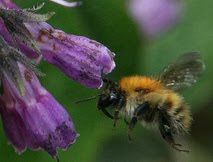
Borage, to the right of the paver, sage in front, calendula behind it. I used sand to outline things:) The bush is the Julie Child rose, which is suppose to have a tidy shape.

More calendula at the back, more borage to the right of the bee paver and rosemary in front of the borage and thyme to the left of it. You can just see some of the strawberries that have been moved to pots this year (for now)

at the front, (in front of those bricks), another rosemary and pineapple sage, lemon verbena and lemon grass to the left at the back, st. john’s wort

And then another rose bush to the left of everything. I need to work on the path way right through the middle of this. Gerald told me he has to mix up some concrete to set a fence pole soon, so I will be breaking out my Poetry Stone kit, and making path stones with hand and feet prints of the children:)
On the other side of the chain link fence, my friend and neighbor Claude, and I have discussed landscaping that area too:)

This is what the garden bed looked like to the south of the old strawberry weed patch. Believe it or not, there is monardo, two different milkweeds, elderberry, rue, lovage, horseradish, elecampane, st. john’s wort, joe pye weed, feverfew, boneset, more strawberries, daylily, Echinacea and others in this mess:)

Most of that is what is locally known as Creeping Charlie, but ever since I got into herbie things, I have known it as Ground Ivy, Glechoma hederacea. Lucinda wrote a lovely blog post recently about this plant. xx I have some of it juiced and frozen, alcohol tinctured, and honey preserved:) I am blessed with this plant in abundance, and leave it to grow where it will until I need to evict it to allow other things their turn to grow. The honey bees forage it extensively :)
So what can we see after some maintenance?

Joe Pye Weed, Eupatorium maculatum, (the tallest one), Bee Balm, Monarda fistula, Echinacea purpurea, and the Boneset, Eupatorium peroliatum seedlings will be transplanted near this spot too.

Feverfew, Tanacetum parthenium, Butterfly weed, Asclepias tuberosa …

Elderberry, Sambucus nigra, Common milkweed, Asclepias syriacea, Rue, Ruta graveolens, Violets, more Bee balm and Echinacea

That is just another angle of the elderberry, feverfew and butterfly mildweed, and common milkweed, and lovage



That is a currant bush with raspberries behind it. I might end up moving it…

The next part of this side garden goes all the way to the beehive corner and around the south fence. Rose of Sharon, more Ground ivy, raspberries, and the big stand of plants before the hives is sunchokes, from Kristine:)
I am making progress:) Removed a couple of elderberry and raspberries this morning, and passed them on to nephew Scott, to put in over at his house, where we are gardening also:)

Well, that is this weeks garden update! Some of these plants have been established for awhile. Many were originally planted as they are natives, and thus benefit our wild life, besides having herbal usage histories.
Big herbal and honey hugs to all who visit Comfrey Cottages xx














4 comments:
Wow! You have so many different things! I'll have to check out the one that the honeybees love. We have a beautiful golden honey this spring, so far 3 1/2 cases of it! We still have more to spin! No one I'm so tired...............!
You sure do have an extensive variety! Do you let them bloom? Would love to see the Julia Child rose in bloom,
Kathy
With this beautiful weather, the garden looks so different.Good work Leslie!
Big hugs XXXX
How exciting Leslie, you have so many wonderful plants. I love your bee paver, so cute! I have many of the same plants except for some of your American natives. I so love looking at pictures of herby people's gardens, it always gives me inspiration and a sense of community, even across the many miles between us. :)
Love to you and all your family - human and animal.
xxx
Post a Comment